13 Multichannel marketing objectives (plus tips to achieve them)
By Sean Tinney May 13, 2024
Nine in 10 marketing leaders say they’re more focused on business objectives now than they were five years ago.
Despite this, only one in four identify their marketing objectives before starting the planning process. That’s a big problem: if you’re not crystal clear on your desired outcomes upfront, you risk missing the mark when your campaigns go live.
To help you out, we’ve categorized the 13 most important marketing goals across five key channels:
Let’s get into it…
Email marketing goals

1 – Grow your subscriber list
Even if you have a healthy list of contacts, continuing to gain subscribers is critical to maintaining an engaged audience – after all, the average email marketing list decreases by around 22.5% every year. So if you don’t expand your email list by over 22.5% a year, you’ll slowly watch as your subscribers shrink.
Here are a couple tips to help you nail one of the most important email marketing objectives:
Tip: Make it easy for people to subscribe
You can collect more new contacts with a signup form on the platforms where your company is already the most visible. Take AWeber for example, we have our newsletter signup at the top of every blog post, where we encourage readers to get the latest weekly tips:
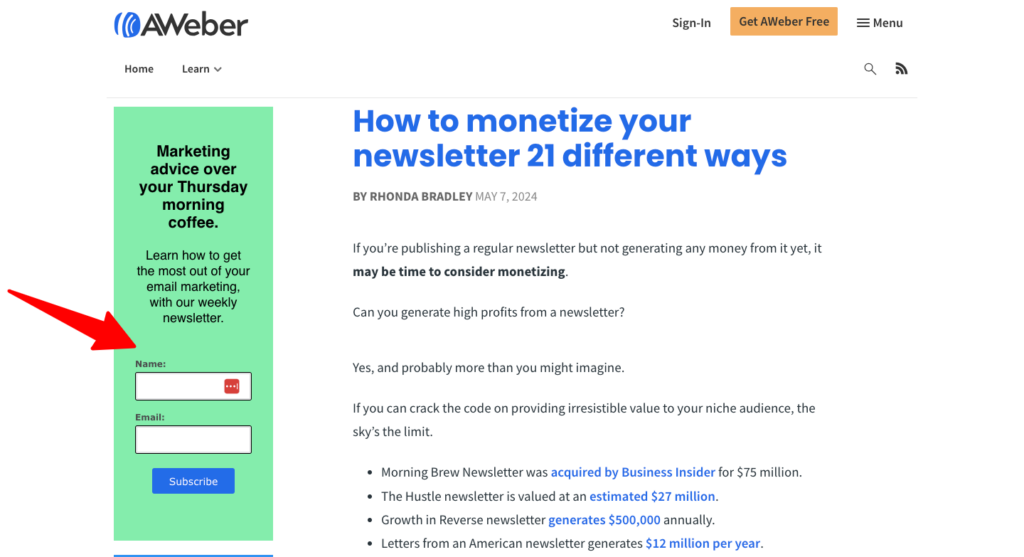
Tip: Give people a reason to subscribe
Most people are protective about their personal information and require a compelling reason to give you their email address; it’s crucial that your audience understands the value of your emails from the get-go. Want to show value? Here are a few ways:
- Explain what your audience will receive in your emails and how frequently they’ll get them.
- Add positive feedback (social proof) from current subscribers.
- Advertise a freebee, promo code, or other lead magnet in your sign up form and make sure it goes out automatically in your first welcome email.
E.g. When you land on The Honey Pot’s homepage, you’ll see a popup offering 15% off in exchange for handing over your email address. Even better, they gamify the experience by first asking you a quiz question about your personal care preferences:

👉 Learn more: 13 Ways to build your email list for free
2 – Increase your email open rates
The more people open your emails, the more opportunities you’ll have to turn them into loyal customers or brand advocates. And you won’t make many sales via email if no one opens your emails. Use these tips to boost your open rate:
Tip: Write clickable subject lines
Almost half of respondents decide to open an email based on the subject line alone. Follow our guidance to make your subject lines more clickable:
- Keep it short and sweet. AWeber’s analysis of 1,000 subject lines from today’s top marketers showed the average subject line was 44 characters long.
- Use actionable language like “get”, “claim”, and “shop” to persuade readers to click.
- Create a sense of urgency with phrases like “limited-time only”, “hurry”, and “last chance”. You can also reference how much time is left on an offer (like “25% off sale ends in 24 hours!”).
- Use personalization and emojis to help make your emails pop, just like these examples:

👉 Learn more: 14 email subject line best practices to get more opens
Tip: Use double opt-ins
What’s the best way to ensure your subscribers are engaged? By getting permission from contacts before adding them to your list. After someone subscribes, send them an email that:
- Reminds them what they signed up for (and why)
- Asks them to confirm their subscription
Here’s a great example of a double opt-in email from Stripo:
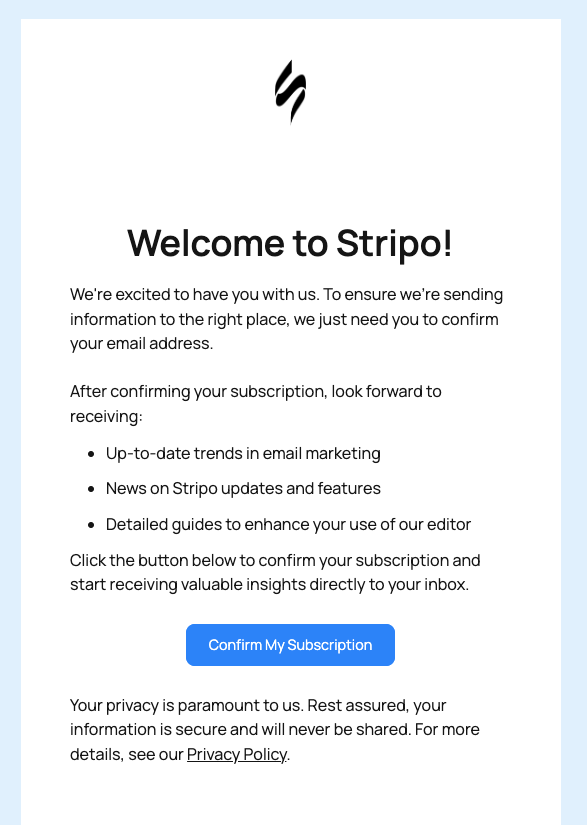
Nail your double opt-in emails and you’ll only be targeting truly engaged subscribers.
3 – Improve email click-through rates
Click-through rates (CTRs) measure the number of subscribers who click on the links in your emails. High click-through rates are a good indicator of a strong relationship with your subscribers. And we all know better relationships result in longtime customers, word-of-mouth referrals, loyalty, and other opportunities to bring in more business.
If improving your click-through rates is among your digital marketing objectives, focus on these email essentials:
Tip: Demonstrate value
Any time your subscribers read an email, they will always ask themselves, “What’s in it for me?”
If you can clearly identify what subscribers will get out of the email (whether it’s education, an exclusive offer, or something else), then it passes the test.
For example, Moment communicates the value of its online courses by referencing its:
- Low prices
- Experienced coaches
- Range of learning materials

Tip: Include a clear CTA
Every email should include a single call to action (CTA) that visually pops — whether it’s downloading an ebook, reading a blog post, or scheduling a free consultation. Each CTA should offer something valuable to subscribers and stand out from the rest of your email. Experiment with its placement, wording and design to determine what kind of CTA creates a higher click-through rate.
In this email below, Candace Payne makes it easy for new subscribers to download the incentive offered on her signup form:
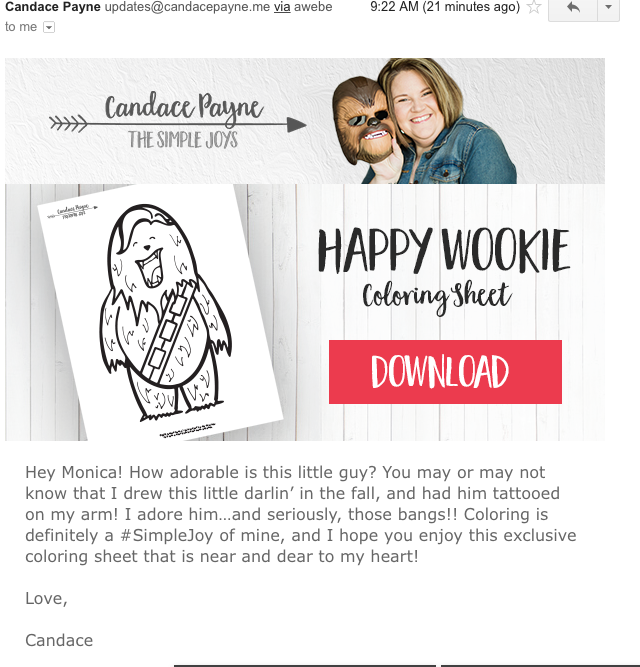
4 – Retain current customers
Customer retention is crucial to the success of any business. Emails have the unique ability to build relationships with past customers, prompting them to purchase from you again in the future.
To boost engagement among your existing customers, here are some tactics to consider:
Tip: Send exclusive content and targeted offers
It’s critical to maintain relationships with them now that they’ve become customers. This can help establish a relationship that is based on trust, appreciation, and authenticity.
One of the best ways to do this is to offer exclusive sales and discounts, courses, ebooks, and other content based on their interests. Segmenting customers in this way can help you send targeted content to people who want it most.
Consider sending emails based on:
- Past email engagement (if they clicked a link for a specific product, they may be interested in more content related to that topic)
- Interests
- Previous purchases
- Pages viewed
- Geographical location
For example, flower delivery service Bloom & Wild allows shoppers to save important dates (like birthdays and anniversaries) in their customer accounts. When one of those days approaches, they send you a reminder email with a discount code, encouraging you to buy again:

Tip: Feature user-generated content and customer testimonials
Highlighting customers by sharing feedback or social posts about their experiences with your brand proves that you value their support. It also incentivizes other customers to follow suit and share their own experiences, in the hopes of getting recognition from your business.
For instance, in our next example, Bite Toothpaste shared product reviews from existing customers — followed by a “shop now” CTA to incentivize purchases:

👉 Learn more: Increase repeat purchases with these 5 easy tips
5 – Reduce unsubscribes
Every business has unsubscribes. In fact, having people unsubscribe from your list is actually a good thing. Why would you want to continue emailing someone who clearly has no interest in your content?
However, if your unsubscribe rate is consistently above 0.5%, it’s time to take action. Consider these tactics to reduce your unsubscribe rate:
Tip: Use double opt-ins
Just as double opt-ins can help improve your email open rates, they can also decrease your unsubscribe rate. This confirmation will reduce the number of customers unsubscribing because they have taken that extra step to verify that they want your content.
Tip: Segment your list
The more relevant your emails, the less likely people are to unsubscribe. So it pays to segment your list by common interests, then send content or offers that are more valuable to a specific audience.
👉 Learn more: 20+ Ways to segment your emails to boost your marketing efforts
Social media goals
1 – Increase your follower count
Growing your follower count is one of the most common social media objectives — because the larger your social following, the more people will see your content. Which, in theory, means more clicks and sales).
Here are a couple tips to boost your followers:
Tip: Optimize your social profiles
Make your profile more discoverable by researching keywords your target audience might be searching for, then adding those terms to your social media bio and/or description.
For example, Mikhail Gribov (AKA Insta Coach Mike) is one of the first profiles to show up in an Instagram search for “social media coach”, no doubt because his bio contains that exact phrase:

Tip: Collaborate with micro-influencers
Influencer marketing helps you reach new followers by teaming up with creators who already have an established audience.
Don’t worry if you don’t have the marketing budget to work with a Kardashian, because smaller accounts actually see higher engagement rates. For instance, on Instagram, micro-influencers (those with <15,000 followers) see three times the engagement of accounts with 1+ million followers.

👉 Learn more: How to increase brand awareness on social media: 25 tips with expert insights and stories
2 – Boost your engagement rate
Your social media engagement rate is the proportion of your followers that likes, shares, and comments on your posts. A higher engagement rate proves you’re creating content that resonates with your target audience. Here are some tips to grow engagement:
Tip: Use the right content formats
If you’re striving for a higher engagement rate, it pays to prioritize the content formats that users find most engaging. Research suggests that the average social media user is most likely to engage with short-form video, images, and live video…
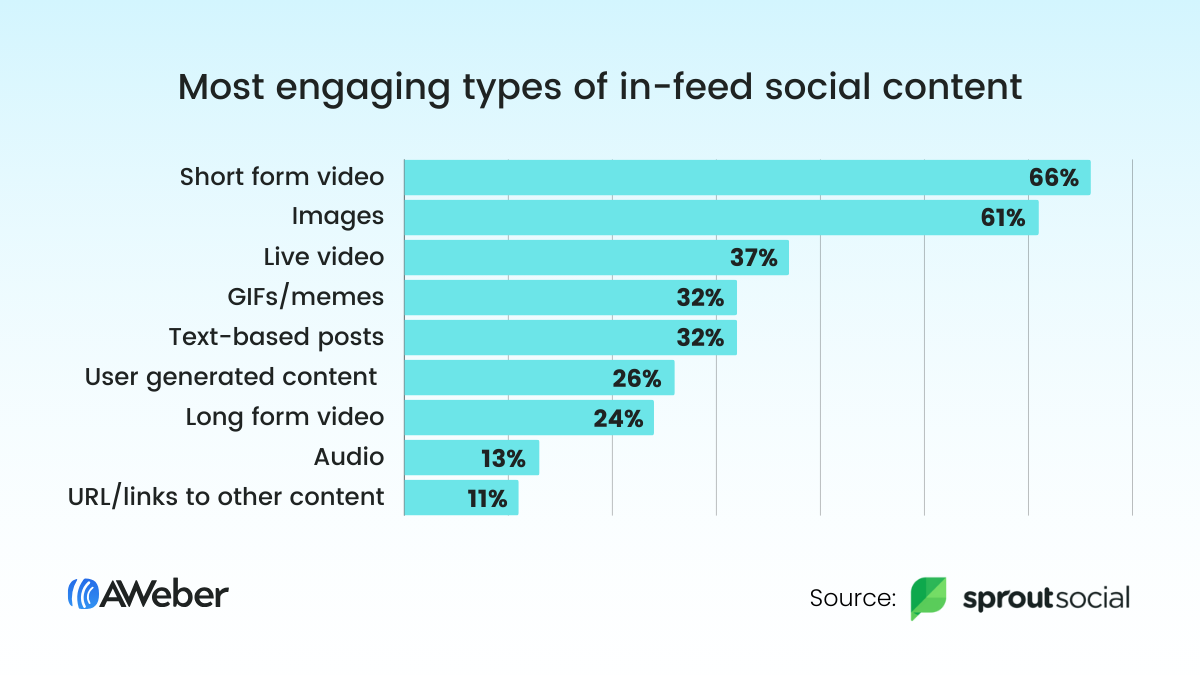
…but your followers might have different tastes, so be sure to experiment with different content types to see what plays best with your audience.
Tip: Post at the right times
You’re more likely to generate a ton of engagement if you post when your followers are online. Groundbreaking stuff, right?
The best time to post varies slightly between social platforms, but in general, peak engagement times are between 9 am and 2 pm from Tuesdays – Thursdays.
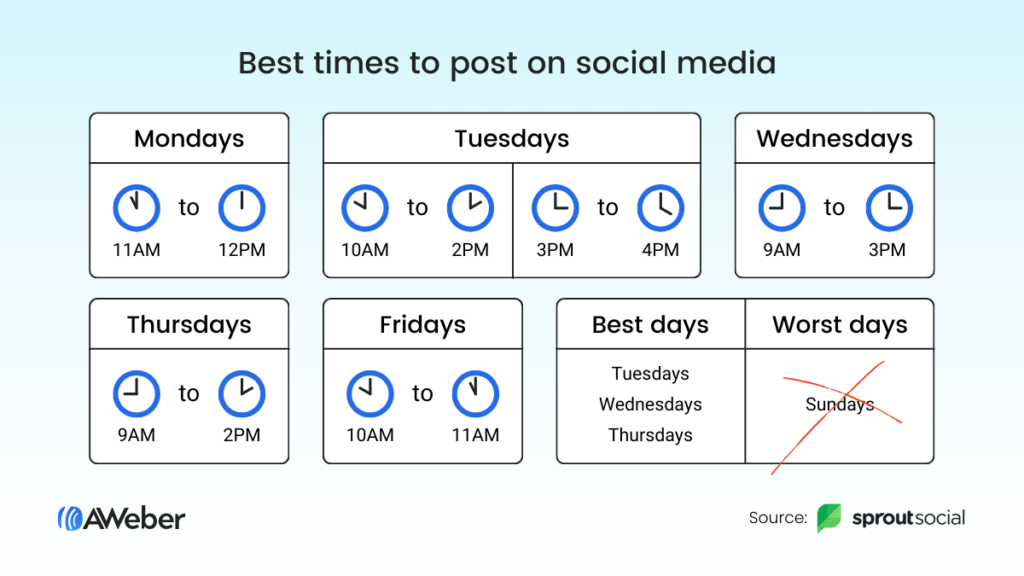
But, again, we’d recommend keeping close tabs on your social media analytics to understand when your specific audience is most likely to engage with your content.
👉 Learn more: Interactive Posts: Steal these ideas and say goodbye to boring social media
Content marketing goals
1 – Generate more conversions
Marketers are most likely to measure the effectiveness of their content programs based on the number of conversions they generate.
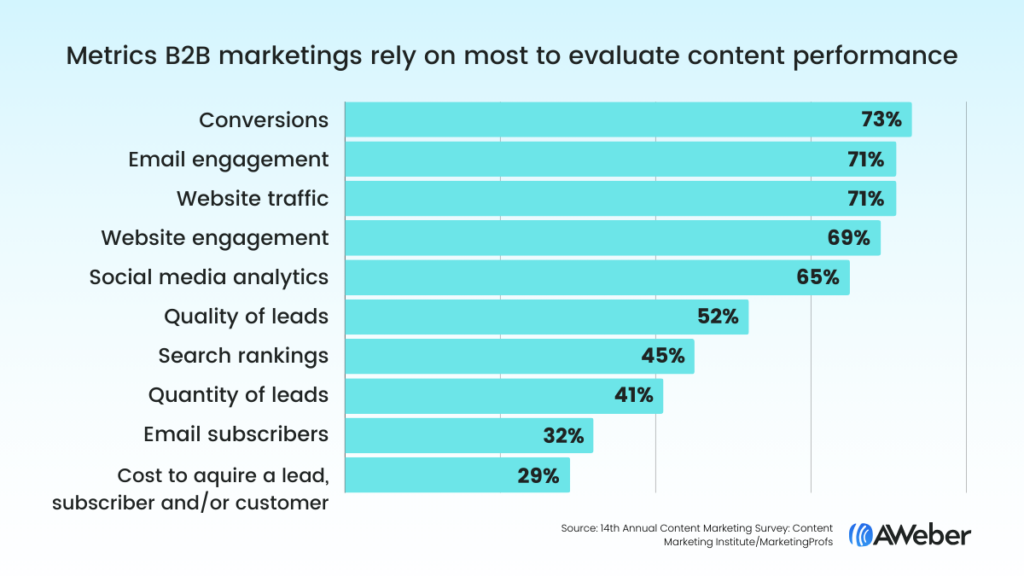
Of course, the word “conversion” means different things to different brands. For some, it might mean email signups and demo requests, while for others, it translates to sales and revenue. Whatever it means to you, here are a couple general tips to generate more conversions from your content:
Tip: Create actionable content
When people read your content, don’t make them guess their next move: tell them what you want them to do by adding clear CTAs. For instance, check out all the calls to action we added to one of our recent blog posts, prompting visitors to sign up for a free AWeber account and/or join our affiliate program:
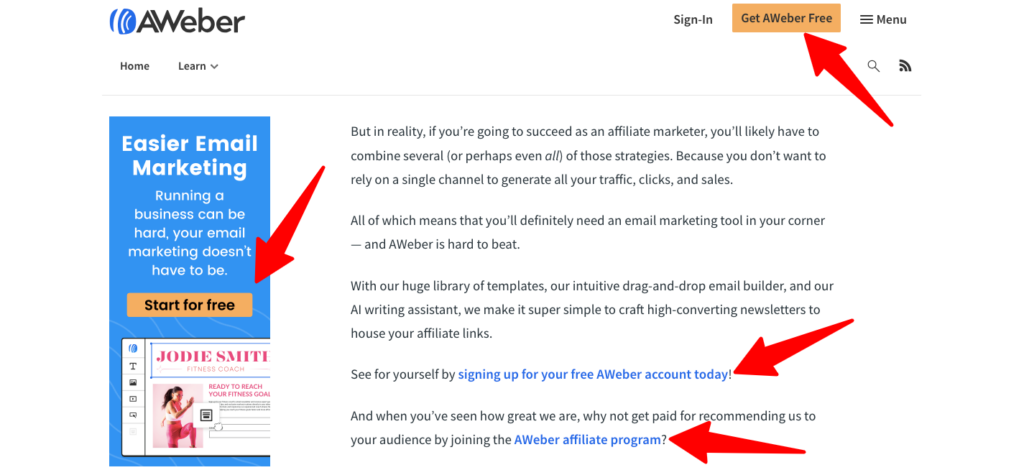
Tip: Create lead magnets
Lead magnets are what they sound like: pieces of content that you give away to potential customers in exchange for some personal information (typically, their name and email address). As such, they play a key role in the lead generation process.
For example, we created a campaign targeting people who want to learn about using email marketing to grow a business:

👉 Learn more: 25 brilliant lead magnet ideas to grow your email list right now
2 – Increase website engagement
Tip: Steer readers toward relevant content
If someone loves your content so much that they read all the way to the end of an article, encourage them to keep reading by sharing other relevant blogs (or other content) on your site:

That way, there’s a chance they’ll stick around longer, increasing your website engagement metrics.
Tip: Add internal links
In our opinion, effective internal linking is the simplest way to boost engagement with your website.
To be clear, an internal is one that points to a different page on your website. By encouraging readers to click through to additional content, you can improve your bounce rate and average session duration. For best results, the anchor text — that is, the words containing the hyperlink — should give the reader a clear idea about what they’re about to click:
❌ Bad: Click here for our latest guide
✅ Good: Learn more in our guide to landing page best practices
👉 Learn more: 5 SEO best practices to increase blog traffic and engagement
SEO goals
1 – Increase organic traffic
Boosting organic traffic is one of the most important digital marketing objectives, given that organic search is the second most important source of website traffic across all industries:
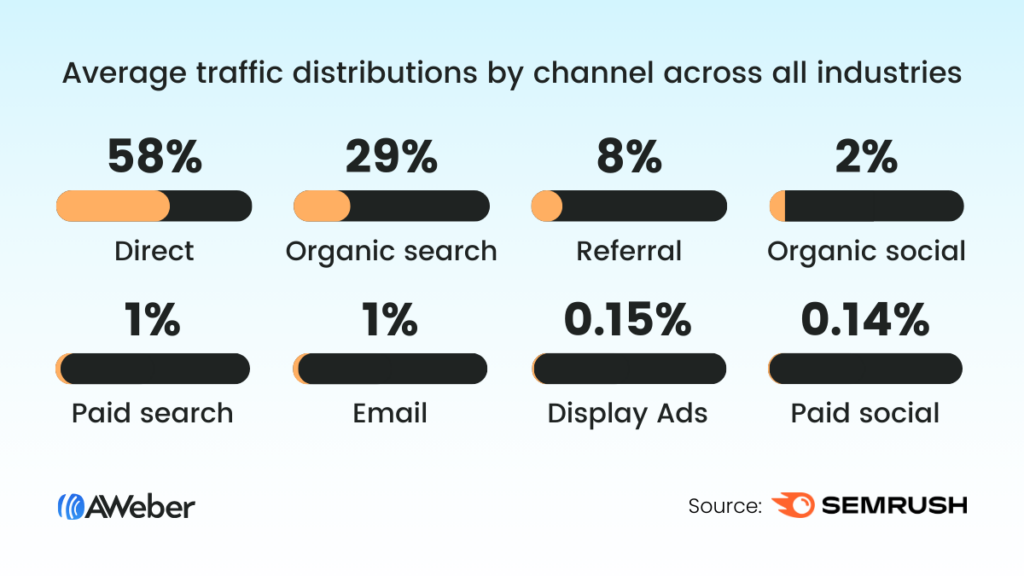
SEO can be a tough nut to crack, especially for less-experienced marketers. But there are a couple steps you can take to give your organic traffic a shot in the arm:
Tip: Steal your competitors’ backlinks
We’ve already mentioned one important type of link: internal links.
But there’s another type that plays a key role in SEO — external links, otherwise known as backlinks. As the name suggests, these are links pointing to your site from other websites.
Search engines treat this as a signal that your content is trustworthy, which can boost your search performance. Indeed, the average #1 search result has 3.8X more backlinks than those in positions #2 – #10.

Want a quick-and-dirty way to grow more backlinks? Follow this process:
- Choose a primary keyword that’s relevant to your audience
- Identify the page that currently ranks #1 for your target term
- Create the best possible piece of content targeting your desired keyword
- Find sites that link to the current #1 page using an SEO tool like Ahrefs or Semrush
- Reach out to those sites and ask them to link to your content instead
Tip: Speed up your website
Consumers hate slow-loading web pages, with 32% saying they’d never visit a site again if it took too long to load. Brutal, huh?

Because search engines strive to deliver the best possible results to searchers, they’ll punish slow websites with lower rankings. So it’s clearly in your best interests to create a slick, speedy experience for searchers.
To do this, make sure you:
- Use tools like TinyPNG and Freeconvert to compress onsite images and videos
- Identify (and correct) issues slowing down your site using Google’s free PageSpeed Insights tool
👉 Learn more: Optimize your blog post for SEO & go from zero traffic to monthly growth
2 – Grow organic leads
Having lots of traffic is all well and good, but it doesn’t count for much if none of those visitors turn into leads (and, eventually, paying customers). For that reason, lead generation is one of the most common SEO marketing objectives.
Use these tips to generate more leads from your organic search strategy:
Tip: Target long-tail keywords
Long-tail keywords are extremely specific search queries. Their specificity means they generally have:
- More words (typically 3+)
- Lower search volume
- Lower competition
- Higher purchase intent
Let’s consider a few examples:

Targeting these sorts of long-tail terms might not drive a ton of traffic to your site. But, on the flip side, a much higher proportion of your visitors will be in the market for your product or service.
Tip: Build an SEO landing page
SEO landing pages are web pages that are built to:
- Rank well in search
- Drive lots of leads or sales
Whereas standard web pages might serve a wide range of audiences and marketing goals, SEO landing pages are designed to fulfill a single purpose — typically generating leads or sales.
For instance, this simple landing page…
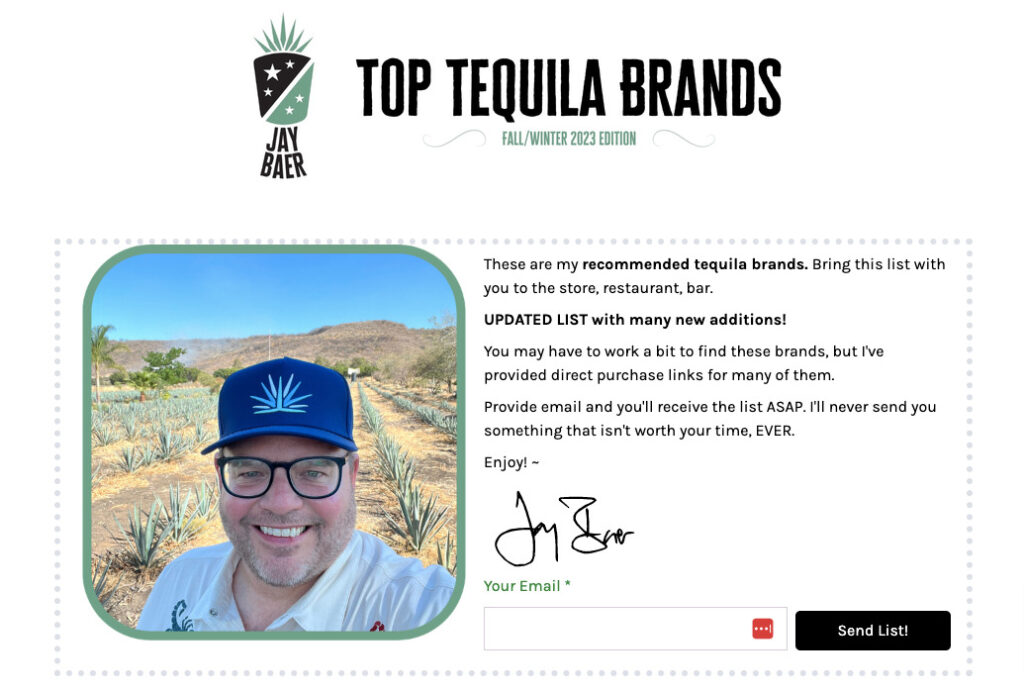
…previously ranked at #6 for the term “tequila lists”, which likely helped creator Jay Baer capture a bunch of email addresses for his newsletter.
👉 Learn more: Landing page SEO best practices: A step-by-step guide
PPC goals
1 – Improve your click-through rate
On a basic level, a higher CTR is a good thing because it means your PPC campaigns are generating more traffic.
But there’s another big benefit: Google takes your click-through rate into account when calculating your Ad Rank, which determines how high up your ads will appear in relevant search results. The higher you rank, the more clicks you’ll win. Nice!
Here are some simple ways to boost your PPC CTR:
Tip: Set negative keywords
Setting negative keywords means your ads won’t appear in searches for those terms, helping you avoid audiences that just aren’t a good match for your product or service.
For example, a SaaS company selling enterprise-grade budgeting and forecasting software likely wouldn’t want to target someone trying to plan their household budget. So the brand might set negative keywords like “household budgeting tool” and “personal budget tool”.

By effectively ruling out certain audiences, negative keywords ensure your ads are only seen by relevant searchers who are more likely to click through.
Tip: Add sitelink extensions
Sitelink extensions are additional links to key pages on your website that appear beneath high-ranking PPC ads. These links allow you you seize more “real estate” on search engines result pages…

…which helps your ads stand out more, thereby boosting your click-through rate.
Google lets you create up to 10 sitelink extensions for each ad. But, as with so many things, the search engine has total control over which (if any) links it displays.
2 – Drive more sales
For most brands, the ultimate goal of any PPC campaign is to sell more. Here are a couple tips to help you do exactly that:
Tip: Create unique landing pages for different audiences
Relying on a single post-click landing page is one of the most common PPC errors.
Even if your product or service is super specific, chances are you have several audiences. For example, GEICO runs PPC ads targeting “regular” consumers…

…and commercial truck insurance customers:

Those are totally different audiences with highly specific motivations and pain points. It’d be impossible to create a single landing page that speaks effectively to both.
There’s a simple lesson here: creating dedicated landing pages for each audience type gives you a far better chance of selling to them.
Tip: Align your ad copy and landing page
We’ve seen countless examples of brands building beautiful, high-converting PPC landing pages, only to write terrible ad copy that doesn’t match the landing page’s tone or content. This disconnect is a real conversion rate killer.
Zoho gets it right. At time of writing, it was targeting the keyword “social media management software”, with ad copy promising an “all-in-one” solution:

When you click through to the landing page, you’re presented with intro copy spelling out some of the platform’s key features, like:
- Scheduling unlimited posts
- Monitoring what matters
- Creating custom reports
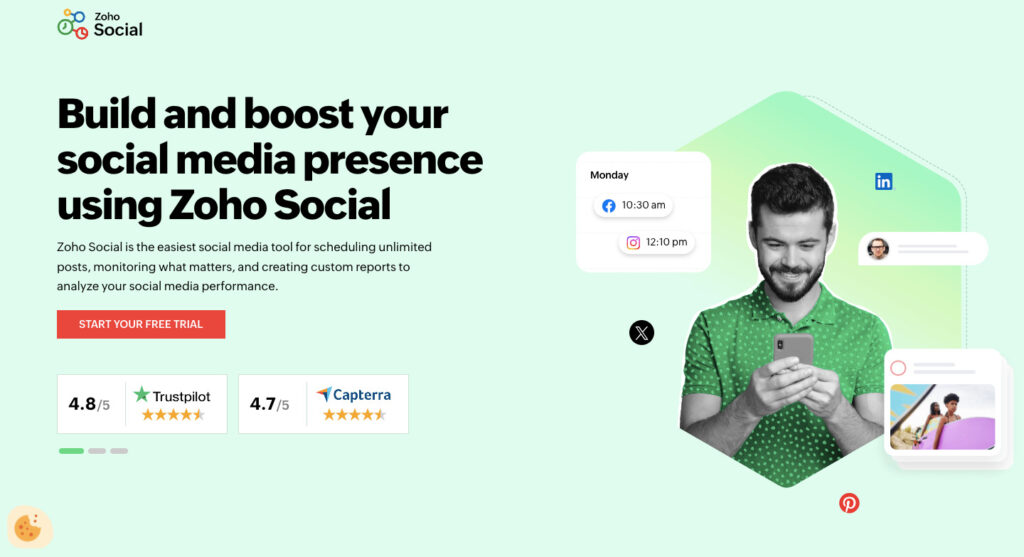
All the sort of stuff you’d expect an all-in-one social media management tool to offer, right?
👉 Learn more: How to create landing pages that convert (plus top examples & templates)
Smash your multichannel marketing goals with AWeber
Each channel has its own marketing objectives (and tactics for achieving them). But AWeber can help you reach many of those goals.
Our feature-rich platform can level up your email marketing results with our drag-and-drop builder, template library, and smart-but-simple automations. Plus our intuitive landing page builder supports your strategies across multiple other channels, from PPC to social media to SEO.
Give it a try by signing up for your free AWeber account today!
FAQs
What are marketing objectives?
Marketing objectives are specific goals for measuring the success of marketing campaigns. Aligning your marketing objectives with your overarching business goals helps to ensure your marketing activities have the biggest possible impact on your company’s growth.
What makes a good marketing objective?
Good marketing objectives should be SMART (specific, measurable, achievable, relevant, and time-bound). For example: increase email newsletter click-through rate by 10% in the next three months.
Peter Cayetuna
5/15/2024 7:21 pmThe article is very informative and the one that I most agree upon is the use of SMART method in creating goals. This indeed provides a good outline giving a clear path on what you want to achieve on marketing.